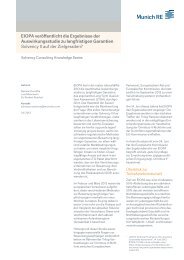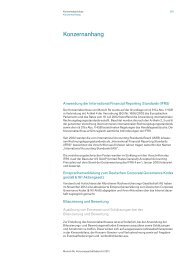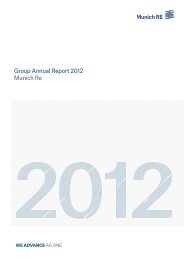Munich Re Group Annual Report 2006 (PDF, 1.8
Munich Re Group Annual Report 2006 (PDF, 1.8
Munich Re Group Annual Report 2006 (PDF, 1.8
You also want an ePaper? Increase the reach of your titles
YUMPU automatically turns print PDFs into web optimized ePapers that Google loves.
<strong>Munich</strong> <strong>Re</strong> <strong>Group</strong> <strong>Annual</strong> <strong>Re</strong>port <strong>2006</strong> Notes_Disclosures on the uncertainties of future cash flows from insurance contracts<br />
of the trend factors may result in a change in the provision for<br />
adverse deviation allowed for in the actuarial assumptions. This<br />
does not directly affect the value of the technical provisions or the<br />
deferred acquisition costs as long as there is sufficient provision for<br />
adverse deviation. In the view of the actuaries responsible, the biometric<br />
actuarial assumptions used by us are deemed to be sufficient<br />
and contain adequate provision for adverse deviation.<br />
For annuity insurance contracts, the longevity risk plays an<br />
especially significant role. In primary insurance, the provisions for<br />
adverse deviation in our portfolio of annuity insurance policies have<br />
decreased in the past. If the longevity trend intensifies further compared<br />
with assumptions, additional amounts may have to be allocated<br />
to the provision for future policy benefits in the future. The<br />
longevity risk in our reinsurance portfolio has significantly less<br />
weight than in primary insurance.<br />
In the health segment, we are proceeding on the assumption that<br />
there will be further advances in medical treatment, potentially giving<br />
rise to higher costs. If it is foreseeable that the assumptions behind<br />
the calculation are permanently inadequate to cover expenses<br />
for claims, it is possible to adjust premiums for long-term contracts,<br />
thus limiting the financial and balance-sheet effects of permanent<br />
changes in morbidity.<br />
However, such biometric risks may accumulate or be aggravated<br />
as a result of interventions by legislators or courts in the distribution<br />
of risks and rewards underlying the contracts concluded between the<br />
parties to insurance. For example, in the proposed German health<br />
reform, the rules envisaged for the portability of ageing reserves or<br />
the option for clients to switch to a “basic policy” could significantly<br />
disrupt the proven system of collective risk balancing between policyholders<br />
and the reasonable balance of interests between insurance<br />
companies and their insureds.<br />
Discount rates used for provisions – <strong>Re</strong>insurance (gross)<br />
Interest-rate risks<br />
Interest-rate risks have to be taken into account in both reinsurance<br />
and primary insurance. A distinction must be made between risks of<br />
changes in interest rates on the one hand and interest-rate guarantee<br />
risks on the other. Risks of changes in interest rates would result<br />
from the discounting of the provision for future policy benefits and<br />
of parts of the provision for outstanding claims. In accordance with<br />
accounting valuation rules, the discount rate is fixed at contract commencement<br />
and will generally not be adjusted during the term of the<br />
contract. To this extent, the accounting valuation of the technical provisions<br />
is not directly dependent on the level of the market interest<br />
rates.<br />
Economically, however, an interest-rate risk derives from the<br />
need to earn a return on the investments covering the provision<br />
that is commensurate with the discount rate used in measuring the<br />
provision.<br />
In reinsurance, such an interest-rate risk can frequently be ruled<br />
out through suitable treaty design. For many treaties, the interest on<br />
technical provisions is secured by an inflow of investment income<br />
from deposits retained that is guaranteed by the ceding company.<br />
For the remaining portion of the €16,534m (19,281m) total provision<br />
for future policy benefits and provision for outstanding claims, we<br />
use the following discount rates:<br />
All figures in €m 31.12.<strong>2006</strong> Prev. year<br />
Discount rate 2.5% 12 3<br />
Discount rate 2.5–3.5% 661 296<br />
Discount rate 3.5–4.5% 490 479<br />
Discount rate 4.5–5.5% 2,242 2,513<br />
Discount rate 5.5–6.5% 1,099 1,116<br />
Discount rate 6.5–7.5% 330 340<br />
Discount rate > 7.5% 101 100<br />
Total 4,935 4,847<br />
For the whole portfolio, including that part where we use high discount<br />
rates for historical reasons, we check by means of the liability<br />
adequacy test as per IFRS 4 that the expected income from the<br />
investments covering the technical provisions is sufficient to meet<br />
future obligations.<br />
In life primary insurance, an implicit or explicit interest-rate guarantee<br />
is granted for the majority of contracts, based on an actuarial<br />
interest rate applying at the time the contract is concluded. An appropriate<br />
minimum return needs to be earned in the long term from the<br />
investment result (possibly also with assistance from the underwriting<br />
result) for the contractually guaranteed benefits. In health primary<br />
insurance, an actuarial interest rate is also used for calculating<br />
the provision for future policy benefits, but this rate can generally be<br />
altered by way of premium adjustment.<br />
201

















